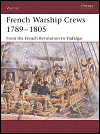Book
Review:
French Warship Crews, 1789 to 1805
By
Terry Crowdy
Artwork by Steve Noon
 With
so much information around about the British Royal Navy during
the Napoleonic Era, it great to have a view of the other side
via Osprey's French Warship Crews 1789 to 1805.
With
so much information around about the British Royal Navy during
the Napoleonic Era, it great to have a view of the other side
via Osprey's French Warship Crews 1789 to 1805.
This
is an excellent addition to any Napoleonic library as it gives
you a superb look at the French revolutionary and Napoleonic navy.
That is before the great disaster that befell it at Trafalgar.
There
are so many new and interesting facts available for myself in
the book it is hard to really know where to start.
French
Warship Crews 1789 to 1805 details the upheavals the navy
went through during revolutionary times and how it lost its most
senior and best officers.
To
crew the ships with experienced men of the sea France had the
Inscription Maritime whereby certain numbers of commercial sailors
had to sign up for the navy on a temporary basis of service. If
there was a shortfall of volunteers for the navy then a levy was
begun calling up bachelors, widowers without children, married
men with kids and finally fathers of families.
One
of the biggest drains on the French naval manpower was the lure
of being a corsair, or privateer, which would pay a lot better
and also provide a life with much more excitement. It was so popular
a service Napoleon had to limit sign-ups to an eight of the number
of conscripts.
Life
at sea was as tough for the French sailor as his British counterpart
and Terry Crowdy details their conditions aboard a vaisseau, their
food, discipline, drills and punishment.
The
eyewitness accounts included in the book are terrific and bring
to life a section of the French military that is rarely covered
in English.
You
also get a run down of French naval ranks from gabiers and matelots
(sailors) a capitaine de vaisseau (captain) and learn about their
training, status and education.
French
ships (vaisseau) were rated in two main ways. The large battleships
of the line were on the number of guns, like the Royal Navy, and
were known as vaisseau de 118 or vaisseau de 80, but frigates
were listed by the calibre of their weapons. For example a fregate
de 18 would carry 28 18-pounders and a fregate de 12 would have
26 12-pounders.
French
Warship Crews 1789 to 1805 has a superb coloured ullustration
section by Steve Noon that covers aspects of a sailor's existence
from recruitment, to relaxing ashore and being in battle. I particularly
appreciate the yardarm view of a sharpshooter raising his musket
while overlooking a certain Admiral Horatio Nelson.
French
Warship Crews 1789 to 1805 is filled with great information
presented in a very readable and interesting way.
-
Richard Moore
8.5/10
Osprey
Website